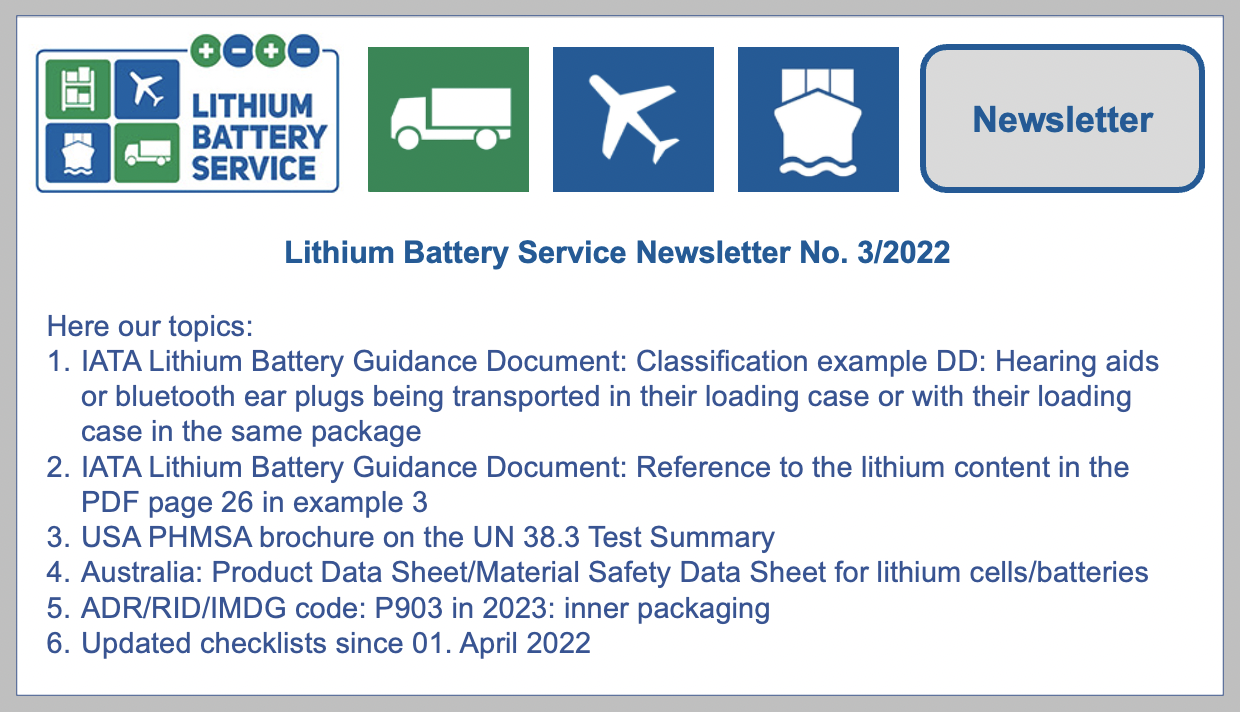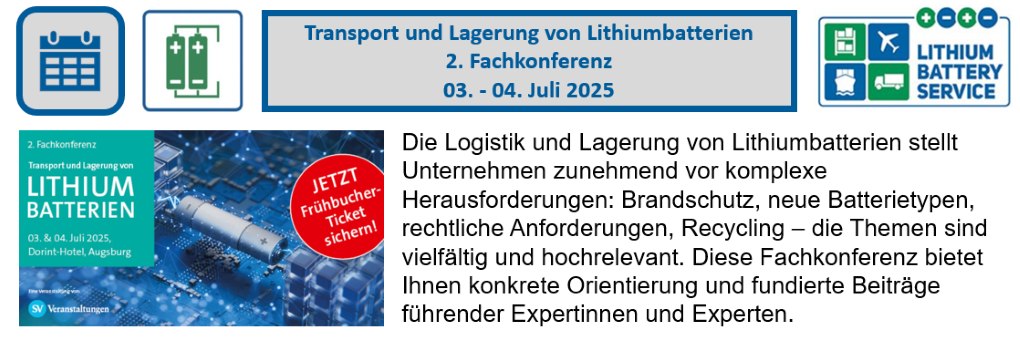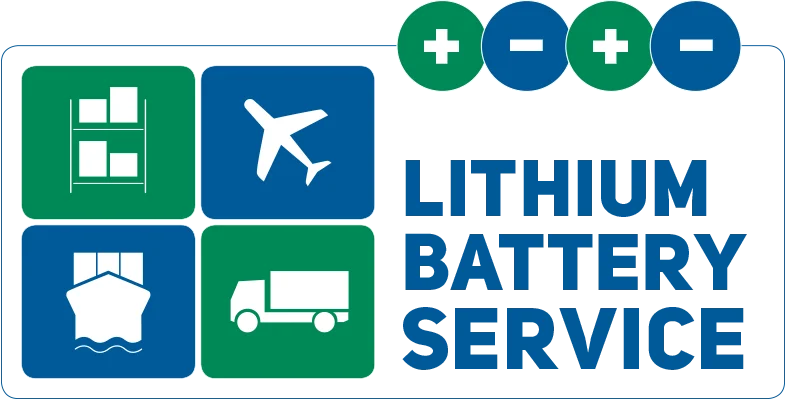Newsletter No. 03 / 2022
Newsletter No. 03 / 2022 Here our topics: 1 IATA Lithium Battery Guidance Document: Classification example DD: Hearing aids or bluetooth ear plugs being transported in their loading case or with their loading case in the same package 2 IATA Lithium Battery Guidance Document: Reference to the lithium content in the PDF page 26 in example 3 3 USA PHMSA brochure on the UN 38.3 Test Summary 4 Australia: Product Data Sheet/Material Safety Data Sheet for lithium cells/batteries 5 ADR/RID/IMDG code: P903 in 2023: inner packaging 6 Updated checklists since 01. April 2022

Dear Lithium Battery Service Customers,
following our last newsletter we got several feedbacks questioning the information provided.
Lithium Battery Service exists because the regulations on shipping lithium cells and batteries are so complex that being in compliance with them is a real challenge.
Since the end of January we had discussions with the German authorities and now we can inform you about the results. Yet a note describing the basis for the interpretations is missing in the text of the regulations.
Here our topics:
- IATA Lithium Battery Guidance Document: Classification example DD: Hearing aids or bluetooth ear plugs being transported in their loading case or with their loading case in the same package
- IATA Lithium Battery Guidance Document: Reference to the lithium content in the PDF page 26 in example 3
- USA PHMSA brochure on the UN 38.3 Test Summary
- Australia: Product Data Sheet/Material Safety Data Sheet for lithium cells/batteries
- ADR/RID/IMDG code: P903 in 2023: inner packaging
- Updated checklists since 01. April 2022
1. IATA Lithium Battery Guidance Document: Classification example DD: Hearing aids or bluetooth ear plugs being transported in their loading case or with their loading case in the same package
In 2019 we discussed this classification topic with the LBA (German Civil Aviation Authority) and with PHMSA (the authority for dangerous goods transport at the US transport ministry). The interpretation then was clear that the loading case is to be classified as a powerbank. For us this implied that the lithium battery mark on the package needs to have both UN numbers entered, the UN 3480 for the loading case and the UN 3481 for the hearing aids/blue tooth ear plugs. Which meant that in air transport the package is cargo aircraft only and the state of charge of the loading case must not exceed 30%.
Yet in April 2021 PHMSA published the attached interpretation letter 20-0078 which Bob Richard brought to our notice stating that if the hearing aids/bluetooth ear plugs were packed together with the loading case, the package may be classified as UN 3481.
This interpretation we have discussed at length with the LBA and the BAM and even if in the text of the regulations there is no note to that effect at all, both German authorities are of the opinion that the classification of UN 3481 may be used because the loading case is only for charging those specific hearing aids/bluetooth ear plugs and cannot charge any other pieces of equipment.
Georg Closhen from the LBA stressed the fact that loading such hearing aids/bluetooth ear plugs inside the loading case during air transport is prohibited.
We asked them to add a note that describes this interpretation possibility at the UN respective ICAO level.
Of course we are aware that not every small interpretation can be described in the regulations since the technical development will always way ahead of the regulation text. Yet as shown by the discussion started by our newsletter, it is important to adjust the regulation text to include such everyday products, especially since the interpretation of the authorities cannot be derived from the latest text of the regulations itself.
The aim is to have a regulation text that is as descriptive as possible so that only very few interpretations by the authorities are needed and that an international transport can be conducted directly by complying with the text of the regulations.
2. IATA Lithium Battery Guidance Document: Reference to the lithium content in the PDF page 26 in example 3
In the UN 38.3 Test Summary for lithium cells the lithium content and for lithium batteries the aggregate lithium content need to be stated.
The text of the UN Manual of Tests and Criteria demands a specific value and for this reason we were of the opinion that the example in the IATA Lithium Battery Guidance Document stating a lithium content variance “from.... to...“ was wrong.
We have discussed this with Frank Krischok from the BAM and in his opinion the UN 38.3 Test Summary is only relevant for transport. Whenever a company wants to assemble a battery from cells, the company will need a lot more information on the cell model they plan to use and these can then include the exact lithium content. Therefore in the UN 38.3 Test Summary a lithium content variance may be stated if this variance is within the scope described in the UN Manual of Tests and Criteria in which the UN 38.3 Test Series need not be conducted anew (see 38.3.2.2).
Therefore stating a lithium content variance in the UN 38.3 Test Summary is allowed in general. Yet the example in the IATA Lithium Battery Guidance Document is still incorrect because the lithium content variance described in 38.3.2.2 only allows a variance of max. 0,1 g or 20%.
The description of the maximum variances where no new UN 38.3 Testing is required, is stated in the IATA Lithium Battery Guidance Document for lithium metal cells/batteries under Part 3, B. (a).
3. USA PHMSA brochure on the UN 38.3 Test Summary
Internationally manufacturers and subsequent suppliers need to provide a UN 38.3 Test Summary on request since 01. January 2020.
Within the USA this international requirement was implemented at the turn of the year 2022 by including it in the US American Transport Regulations under 49 CFR, §173.185(A)(3) and it includes a facilitation that we don´t have internationally. For transport within the USA the UN 38.3 Test Summary need only be provided for lithium cells and batteries manufactured on or after 01. January 2008. Internationally the UN 38.3 Test Summary is required for each transported lithium cell and battery manufactured after the 30. June 2003.
And under the following link PHMSA has published a guidance brochure with questions and answers regarding the UN 38.3 Test Summary:
https://www.phmsa.dot.gov/sites/phmsa.dot.gov/files/2022-01/Test%20Summary%20Brochure%20web.pdf
What is interesting is text under A5 explaining what information needs to be given as the physical description of the lithium cell/battery. So far we thought shorter descriptions like e.g. cell in green foil wrap or silver battery case would be sufficient. According to PHMSA the shape, the size and the intended application are part of the general physical characteristics.
The UN Subcommittee has published a similar Question/Answer list and examples of UN 38.3 Test Summaries under this link:
https://unece.org/fileadmin/DAM/trans/doc/2018/dgac10c3/UN-SCETDG-53-INF38e.pdf
Yet the lithium content variance in example 3 is stated incorrectly because it does not comply with the requirements in 38.3.2.2 with max. 0,1 g or 20%.
4. Australia: Product Data Sheet/Material Safety Data Sheet for lithium cells/batteries
Safety data sheets are only required for chemical substances not for equipment/articles. That´s what all states handle it except for Australia. Or to be more precise not even all of Australia but specifically the territories Victoria and Western Australia. In these territories a specific safety data sheet is required for all dangerous goods.
It wasn´t a state authority bringing this on but a state body for occupational safety called “safe work australia” in their publication „Preparation of safety data sheets for hazardous chemicals - Code of Practice“ in subsection 1.4.
With this for all lithium cells and batteries all information required in a safety data sheet needs to be given in the internationally known structure of the safety data sheet.
Yet for battery-powered vehicles (UN 3171) and for lithium batteries installed in cargo transport units (UN 3536) this is not required states Richard Greenwood from RG Chemical Safety after a discussion with their Australian experts group on dangerous goods since these may be considered as „incorporated in plant“. So for these UN numbers it is sufficient to provide a product data sheet describing the safety information for forseeable emergencies to the user.
Should you need assistance in this matter, feel free to contact us or Richard Greenwood.
Here his contact details:
Richard Greenwood
RG Chemical Safety
+61 401 321 962
5. ADR/RID/IMDG code: Inner packagings according to P903 (1) in 2023
The decision on the planned new requirement that lithium cells and batteries according to packing instruction P903 (ADR, RID and IMDG code) need to be placed in inner packagings was moved by the UN subcommittee of experts to the next biennium. This means that a decision on this change will only be made in 2025 so for 2023 everything remains as is without an inner packaging being required.
This has no effect on air transport. Here the existing requirement for an inner packaging remains as is.
6. Updated checklists since 01. April 2022
On 1. April 2022 we have updated our checklists for air transport. This was necessary because Section II of the packing instruction 965 and 968 were deleted. In this context we have re-numbered our checklists:
A-checklists are for air transport (A-Air)
S-checklists are for sea transport (S-Sea)
R-checklists are for road transport (R-Road)
If you want we can send you a document that gives a tabular comparison of the old checklist numbers with the new. Just let us know.
All the best!
Your Lithium Battery Service Team!
Eva Glimsche, Juergen Werny und Robert Wenske












